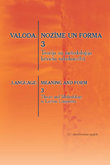Objektu tipi latviešu valodā
Types of objects in Latvian
Author(s): Līga VoginaSubject(s): Language and Literature Studies, Theoretical Linguistics, Semantics, Baltic Languages
Published by: Latvijas Universitātes Akadēmiskais apgāds
Keywords: objekts; tiešais objekts; cietējs; tēma; stimuls; piederums;
Summary/Abstract: Object as a generalized semantic role subsumes different, more concrete semantic roles. Level of generalization usually is based upon the aim of investigation. Well known is division of direct and indirect objects. Each of these two roles can be divided into smaller object roles, but the number and definitions of objects vary from one author to another. Usually the Patient and Theme are described because of their prototypicality. The aim of this article is to describe direct object roles – Patient, Theme and Stimulus – in Latvian and to analyze examples with abstract nouns as object. The investigation shows that transitive verbs can attach abstract nouns with the meaning of process in an object position, e. g.: veikt ūdenssaimniecības attīstīšanu do.INF water_handling_facilities.GEN development.ACC‘to develop water handling facilities’ andveikt aku skalošanu do. INF well.GEN.PL rinsing.ACC ‘to rinse wells’ The formal objects in these sentences are abstract nouns describing processes, but the real direct objects of the situations are expressed with the attribute in genitive. In Latvian these word groups can be replaced with appropriate verb. In such case the position of object is occupied by the attribute i. e. the attribute becomes an object expressed with accusative: attīstīt ūdenssaimniecību (‘to develop water handling facilities’), skalot akas (‘to rinse wells’).
Journal: Valoda: nozīme un forma
- Issue Year: 2013
- Issue No: 3
- Page Range: 132-141
- Page Count: 10
- Language: Latvian

